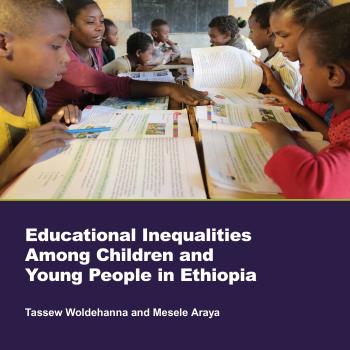Publication Information

The Ethiopian education sector has been one of the most important pro-poor sectors in the country over recent years, with public education spending accounting for 21 per cent of total government spending, and to 4 per cent of GDP, in 2012/13. As the result of this, school enrolment (Grades 1-12) doubled from about 10 million students in 2002/3 to over 20 million in 2013/14. Coupled with the public educational expenditure, the government has also made a number of policy changes in different areas of the sector.
Yet, in spite of the unprecedented enrolment at all levels, the education sector still shows varying degrees of access for different groups, with nine out of ten children of appropriate age enrolled in primary education, two out of ten in secondary education, and only one out of ten at university.
This working paper analyses the educational inequalities that may exist among different groups of children and young people in Ethiopia using Young Lives longitudinal data collected over four rounds of surveys, for two cohorts of children born in 2001-02 and in 1994-95.
The paper’s findings are that overall, although the education system has expanded rapidly, affording access to millions of children who would not have had such an opportunity at the beginning of the Young Lives project in 2002, smooth progression and completion of general, further and higher education remain attainable by only the children of the rich, of educated mothers, of least vulnerable groups, of urban households, and in particular, those residing in Addis Ababa. Recent ‘remarkable’ progress in the sector came from a terribly low base and improvements should be lauded, but many gaps remain to be closed through equitable and inclusive educational policies. An important mechanism will be a revision of public education spending policies, to transfer funds from the higher- to lower-levels in the system; to the levels at which so many of the children from the lowest income quintile and with the least family support are still unable to move beyond.

The Ethiopian education sector has been one of the most important pro-poor sectors in the country over recent years, with public education spending accounting for 21 per cent of total government spending, and to 4 per cent of GDP, in 2012/13. As the result of this, school enrolment (Grades 1-12) doubled from about 10 million students in 2002/3 to over 20 million in 2013/14. Coupled with the public educational expenditure, the government has also made a number of policy changes in different areas of the sector.
Yet, in spite of the unprecedented enrolment at all levels, the education sector still shows varying degrees of access for different groups, with nine out of ten children of appropriate age enrolled in primary education, two out of ten in secondary education, and only one out of ten at university.
This working paper analyses the educational inequalities that may exist among different groups of children and young people in Ethiopia using Young Lives longitudinal data collected over four rounds of surveys, for two cohorts of children born in 2001-02 and in 1994-95.
The paper’s findings are that overall, although the education system has expanded rapidly, affording access to millions of children who would not have had such an opportunity at the beginning of the Young Lives project in 2002, smooth progression and completion of general, further and higher education remain attainable by only the children of the rich, of educated mothers, of least vulnerable groups, of urban households, and in particular, those residing in Addis Ababa. Recent ‘remarkable’ progress in the sector came from a terribly low base and improvements should be lauded, but many gaps remain to be closed through equitable and inclusive educational policies. An important mechanism will be a revision of public education spending policies, to transfer funds from the higher- to lower-levels in the system; to the levels at which so many of the children from the lowest income quintile and with the least family support are still unable to move beyond.

